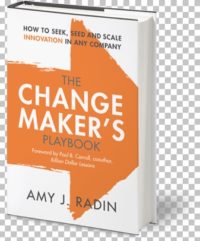In Amy Radin’s new book, The Change Maker’s Playbook: How to Seek, Seed and Scale Innovation in any Company, she suggests several ways in which people can truly innovate within any ecosystem.
Innovation has moved from a distant abstraction to a front-and-center deliverable that is expected to show evidence of impact. But there is no guaranteed formula for finding ideas and executing for sustained impact.
Change makers operate within the polarities of innovation – innovation is cool yet threatening, inevitable yet unpredictable, attractive yet avoided. Change makers are undeterred; they want to solve real problems by getting stuff done, even with the uncertainty, unpredictability and ambiguity that defines their journey.
How do they do it?
Last year I interviewed nearly 50 corporate innovators, startup founders, investors and thought leaders, to get the answer. Seven attributes came through consistently:
1. Change makers are driven by purpose, not fixed targets – so they exceed traditional notions of results.
Purpose means knowing what you stand for—why you want to exist and what mark you want to make. Change makers who put thought into defining their purpose and then connect it to execution energize others with their courage and commitment. It is the fuel that gets entrepreneurs and corporate innovators so fired up that they will not be deterred from pursuing transformative results.
2. Iterate and collaborate – for speed, to conserve capital, and to manage risk
Iterating is a way to learn. Engaging users in a live rendition of a product or service, however rough, narrows gaps between what may be a great idea inside the change maker’s head and a tangible, functional, and sought-after real world product.
Creating and playing with prototypes also builds user, team, and investor buy-in. Such collaboration nurtures creativity, and encourages rallying around a concept. Teams that embrace prototyping advance innovations—testing and learning, engaging with users and with each other, and experimenting without fear of failure.
3. Progress with whatever resources they have – change makers simply know they will find what they need along the way
Change makers don’t wait for resources to be allocated or approved. They have a knack for tracking down the best resources and taking advantage of the vast capabilities that are out there. They search and use the many free or low-cost tools widely available in our self-service world. They are networked.
Being resourceful isn’t annual plan or budget-dependent. Quite the opposite—resourcefulness liberates change makers from putting budget approval on the critical path.
4. Turn to their well-tended networks to chip in guidance and support
It is surprising that there are people out there who still narrowly associate networking with a job search.
Change makers take a wider view of networking: They value relationships with all kinds of people. They are givers, to whom great things happen serendipitously because they have invested in relationships with heart and authenticity. They form genuine no-strings-attached relationships, so what turns out to happen is that people are there to help them along in unforeseeable ways.
Change makers know that putting effort into sutaining and expanding their network is not formulaic, and is a long game. They know that the effort will deliver many rewards, both tangible and intangible.
5. See surprise and serendipity as routine, and use both to gain leverage
Change makers assume surprise and serendipity may present themselves at any moment. They are able to be opportunistic. They pick up added momentum. They are better able to handle and leverage whatever comes their way. They are incredibly focused and stingy about how they spend their time, but they manage to be open to stumbling across new relationships, new insights, new partnerships, and new technologies that make the critical difference at vital moments.
6. Explore and observe – to find the real insights in and beyond the data
Data matters, but change makers do not over-rely on data. They have tremendous empathy so are able, literally, to see people’s needs. They approach data with insight, intuition and observations, beginning with qualitative reasoning and hunches that led to otherwise overlooked discoveries.
Change makers understand their business-model levers. They gather and apply data about how customer behaviors drive financial and operating results, and translate these insights into action.
7. Get in the game, stay in the game, and execute – as a result change makers make the future happen. They don’t watch and wait for the future to unfold.
Being in the game takes courage – to challenge norms, innovate the experience, and believe in the potential to execute at scale based on the view of some future point that cannot be seen yet by others. An entirely new future cannot be brought into focus using the filters of the rear view mirror data mature businesses depend upon to operate and assess performance.
Change makers foresee the trends that rewrite industry norms or even create whole new sectors taking on big, emerging problems.
Final Thoughts
Innovation comes about more as a series of irregular, interconnected, multi-dimensional, moving and messy loops than in a two-dimensional, linear process, so there is risk to presenting any framework for change makers on a two-dimensional plane. But unpacking and simplifying this complexity around these seven common themes also can help change makers see in tangible chunks how to make progress.
Economic and social stability depend upon innovation. The friction of capital and information, and the impediments that used to be caused by distance, time, and space are gone, but getting from imagination to execution continues to be full of challenge. Change makers close the gap between napkin-back idea and real-world impact. Theirs are hard-won achievements, and they deserve our support, mentorship and encouragement.

Above is an excerpt of Amy Radin’s new book, The Change Maker’s Playbook: How to Seek, Seed and Scale Innovation in any Company, offering a framework on how to deliver innovation for sustainable, business-changing impact.

